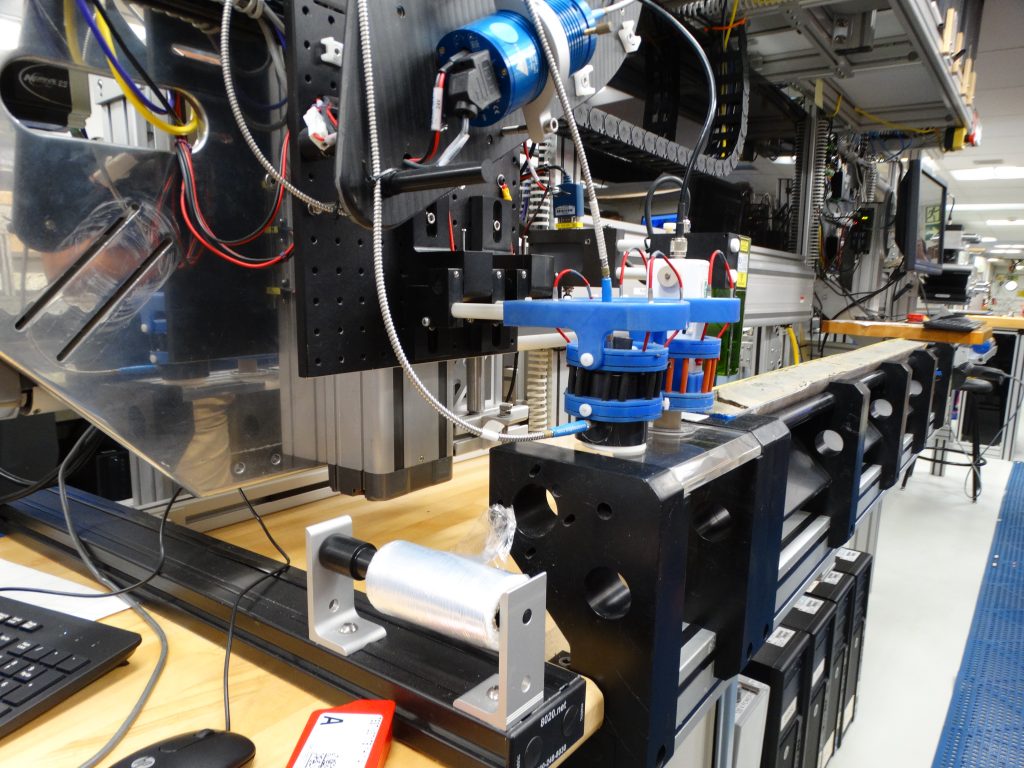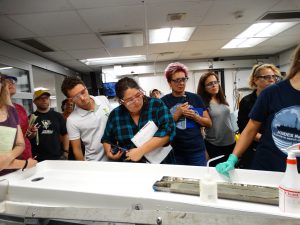
CORE ON DECK!
Another day aboard the JR. For the first time I am seeing people working at sea and eating more than becoming seasick. The ship is incredibly stable and the meals have been fantastic, the galley staff is amazing!
In the morning we continued the mini-course on Oceanography and today the subject was climatic changes based on records in biogenic sediments called foraminiferas. Faced with a robust compilation of data previously collected by the IODP (DSDP, ODP) program in several places on the planet, the event known as PETM (Paleocene-Eocene Thermal Maximum) was more than evident. A significant increase in Earth’s temperature occurred in the passage from the Paleocene to the Eocene. After a careful analysis of the variation in the content of isotopes 13C and 18O in foraminiferas it was clear how much the temperature of the Earth can vary in a short period of time (geologic time!).

The afternoon we worked with a core that had not been opened yet; this made all the rockers extremely excited! With it in our hands, core collected on expedition 361 (east coast of Africa), it was possible to follow the whole core flow after being collected on the JR. Among the measurements made in the core are the physical parameters of the sediments such as velocity of the P seismic wave, magnetic susceptibility and natural emission of gamma rays. After that the core is cut in half, one half is worked on the ship and the other archived. The measures of reflectance and a high resolution imaging part worked on the ship are made. The description of the sediment´s characteristics is performed by the observation of representative samples under a microscope using smear slides. The afternoon ended with a productive discussion on diversity in geosciences, with the central question being “What are elements of a good diversity plan?”.
At nights, SOR participants have the opportunity to present relevant topics of their research. It was a good way to know the work of colleagues in different areas of geosciences.
And so it was another day aboard the magnificent JR. It has been productive days and lots of learning. I am sure I’ll have much to share with my colleagues, students and family when I return to Brazil. Can’t Wait!
Guest Blogger: Miguel Borges, IFPB/UFRN, Brazil.
Mais um dia abordo do JR. Pela primeira vez vejo pessoas trabalhando no mar e comendo mais do que enjoando. O navio é incrivelmente estável e as refeições tem sido fantásticas, o pessoal da cozinha é incrível!
Pela manhã continuamos o minicurso sobre oceanografia e hoje o assunto foi mudanças climáticas com base em registros gravados em sedimentos biogênicos. Diante de uma robusta compilação de dados coletados anteriormente pelo programa IODP (DSDP, ODP) em vários locais do planeta ficou mais do que evidente o evento conhecido como PETM. Um aumento significativo na temperatura da Terra (“máximo termal”) ocorrido na passagem do Paleoceno para o Eoceno. Após uma análise criteriosa de dados da variação no teor de 13C e 18O em foraminíferos ficou claro o quanto a temperatura da Terra pode variar em um curto espaço de tempo (tempo geológico!).
A tarde, pela primeira vez no SOR 2017, trabalhamos com um testemunho que ainda não tinha sido aberto, isso deixou todos os rockers extremamente empolgados! De posse do testemunho coletado na expedição 361, na costa leste da África, foi possível acompanhar todo o fluxo de trabalho de um testemunho após ser coletado no navio. Dentre as medidas realizadas no testemunho estão os parâmetros físicos dos sedimentos como velocidade da onda sísmica P, susceptibilidade magnética e emissão natural de raios gama. Após isso o testemunho é cortado ao meio. Uma metade é trabalhada no navio e a outra arquivada. Na parte trabalhada no navio são feitas ainda medidas de reflectância e um imageamento de alta resolução. A descrição das características sedimentológicas são realizadas pela observação de amostras representativas em microscópio por meio de smear slides. A tarde foi finalizada com uma produtiva discussão sobre diversidade nas geociências, com a pergunta central “Quais são os principais elementos para um bom plano de diversidade?”.
A noites os participantes do SOR tiverem a oportunidade de apresentar temas relevantes de suas pesquisas. Foi uma boa maneira de se conhecer um pouco mais o trabalho dos colegas em diversas áreas das geociências.
E assim se foi mais um dia abordo do magnífico JOIDES Resolution. Tem sido dias produtivos e de muito aprendizado. Com certeza terei muito a compartilhar com meus colegas, alunos e familiares quando retornar ao Brasil.
Miguel Borges, IFPB/UFRN, Brasil.